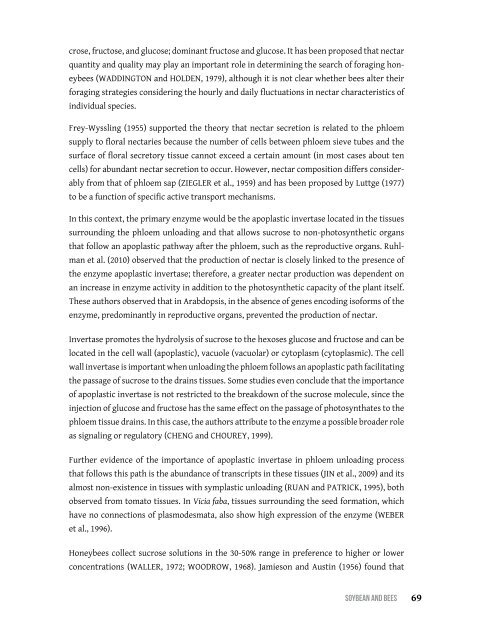Soybean and Bees
You also want an ePaper? Increase the reach of your titles
YUMPU automatically turns print PDFs into web optimized ePapers that Google loves.
crose, fructose, <strong>and</strong> glucose; dominant fructose <strong>and</strong> glucose. It has been proposed that nectar<br />
quantity <strong>and</strong> quality may play an important role in determining the search of foraging honeybees<br />
(Waddington <strong>and</strong> Holden, 1979), although it is not clear whether bees alter their<br />
foraging strategies considering the hourly <strong>and</strong> daily fluctuations in nectar characteristics of<br />
individual species.<br />
Frey-Wyssling (1955) supported the theory that nectar secretion is related to the phloem<br />
supply to floral nectaries because the number of cells between phloem sieve tubes <strong>and</strong> the<br />
surface of floral secretory tissue cannot exceed a certain amount (in most cases about ten<br />
cells) for abundant nectar secretion to occur. However, nectar composition differs considerably<br />
from that of phloem sap (Ziegler et al., 1959) <strong>and</strong> has been proposed by Luttge (1977)<br />
to be a function of specific active transport mechanisms.<br />
In this context, the primary enzyme would be the apoplastic invertase located in the tissues<br />
surrounding the phloem unloading <strong>and</strong> that allows sucrose to non-photosynthetic organs<br />
that follow an apoplastic pathway after the phloem, such as the reproductive organs. Ruhlman<br />
et al. (2010) observed that the production of nectar is closely linked to the presence of<br />
the enzyme apoplastic invertase; therefore, a greater nectar production was dependent on<br />
an increase in enzyme activity in addition to the photosynthetic capacity of the plant itself.<br />
These authors observed that in Arabdopsis, in the absence of genes encoding isoforms of the<br />
enzyme, predominantly in reproductive organs, prevented the production of nectar.<br />
Invertase promotes the hydrolysis of sucrose to the hexoses glucose <strong>and</strong> fructose <strong>and</strong> can be<br />
located in the cell wall (apoplastic), vacuole (vacuolar) or cytoplasm (cytoplasmic). The cell<br />
wall invertase is important when unloading the phloem follows an apoplastic path facilitating<br />
the passage of sucrose to the drains tissues. Some studies even conclude that the importance<br />
of apoplastic invertase is not restricted to the breakdown of the sucrose molecule, since the<br />
injection of glucose <strong>and</strong> fructose has the same effect on the passage of photosynthates to the<br />
phloem tissue drains. In this case, the authors attribute to the enzyme a possible broader role<br />
as signaling or regulatory (Cheng <strong>and</strong> Chourey, 1999).<br />
Further evidence of the importance of apoplastic invertase in phloem unloading process<br />
that follows this path is the abundance of transcripts in these tissues (Jin et al., 2009) <strong>and</strong> its<br />
almost non-existence in tissues with symplastic unloading (Ruan <strong>and</strong> Patrick, 1995), both<br />
observed from tomato tissues. In Vicia faba, tissues surrounding the seed formation, which<br />
have no connections of plasmodesmata, also show high expression of the enzyme (Weber<br />
et al., 1996).<br />
Honeybees collect sucrose solutions in the 30-50% range in preference to higher or lower<br />
concentrations (Waller, 1972; Woodrow, 1968). Jamieson <strong>and</strong> Austin (1956) found that<br />
SoybeAn <strong>and</strong> bees<br />
69


